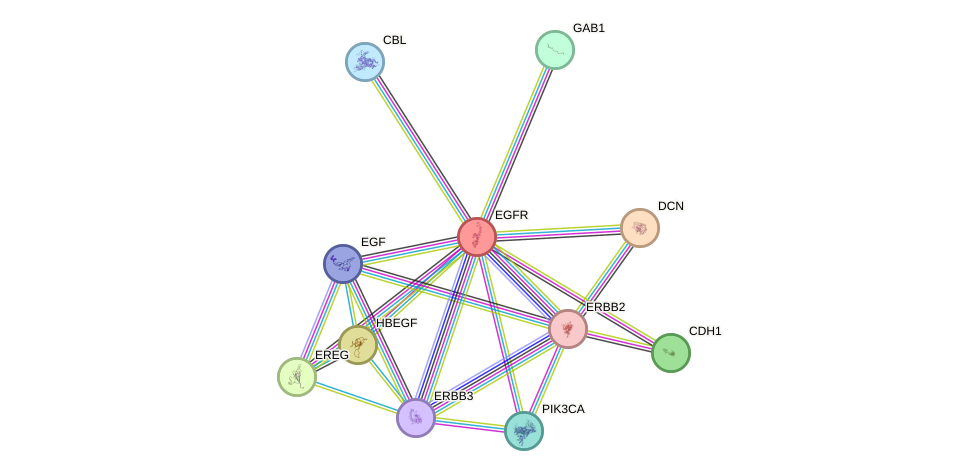GenAge entry for EGFR (Homo sapiens)
Gene name (HAGRID: 40)
- HGNC symbol
- EGFR
- Aliases
- ERBB1; ERBB
- Common name
- epidermal growth factor receptor
Potential relevance to the human ageing process
- Main reason for selection
- Entry selected based on evidence showing that the gene product to be a target of genes previously linked to ageing
- Description
EGFR is a glycoprotein and oncogene involved in cell proliferation. It has been associated with age-related declines in stress-response [1161], but it is not known whether this is a cause or effect of ageing. EGFR has also been related to age-related declines in rat hepatocytes [346]. Whether EGFR plays a role in human ageing remains to be determined.
Cytogenetic information
- Cytogenetic band
- 7p12
- Location
- 55,019,032 bp to 55,207,338 bp
- Orientation
- Plus strand
Protein information
- Gene Ontology
-
Process: GO:0000165; MAPK cascade
GO:0000186; activation of MAPKK activity
GO:0001503; ossification
GO:0001892; embryonic placenta development
GO:0001934; positive regulation of protein phosphorylation
GO:0001942; hair follicle development
GO:0006412; translation
GO:0006950; response to stress
GO:0006970; response to osmotic stress
GO:0006979; response to oxidative stress
GO:0007165; signal transduction
GO:0007166; cell surface receptor signaling pathway
GO:0007173; epidermal growth factor receptor signaling pathway
GO:0007202; activation of phospholipase C activity
GO:0007435; salivary gland morphogenesis
GO:0007494; midgut development
GO:0007611; learning or memory
GO:0007623; circadian rhythm
GO:0008283; cell proliferation
GO:0008284; positive regulation of cell proliferation
GO:0010960; magnesium ion homeostasis
GO:0014066; regulation of phosphatidylinositol 3-kinase signaling
GO:0016101; diterpenoid metabolic process
GO:0016337; single organismal cell-cell adhesion
GO:0018108; peptidyl-tyrosine phosphorylation
GO:0021795; cerebral cortex cell migration
GO:0030307; positive regulation of cell growth
GO:0030324; lung development
GO:0030335; positive regulation of cell migration
GO:0031659; positive regulation of cyclin-dependent protein serine/threonine kinase activity involved in G1/S transition of mitotic cell cycle
GO:0032930; positive regulation of superoxide anion generation
GO:0033590; response to cobalamin
GO:0033594; response to hydroxyisoflavone
GO:0035413; positive regulation of catenin import into nucleus
GO:0035690; cellular response to drug
GO:0038083; peptidyl-tyrosine autophosphorylation
GO:0038128; ERBB2 signaling pathway
GO:0042059; negative regulation of epidermal growth factor receptor signaling pathway
GO:0042060; wound healing
GO:0042177; negative regulation of protein catabolic process
GO:0042327; positive regulation of phosphorylation
GO:0042698; ovulation cycle
GO:0042743; hydrogen peroxide metabolic process
GO:0043006; activation of phospholipase A2 activity by calcium-mediated signaling
GO:0043066; negative regulation of apoptotic process
GO:0043406; positive regulation of MAP kinase activity
GO:0043547; positive regulation of GTPase activity
GO:0043586; tongue development
GO:0045429; positive regulation of nitric oxide biosynthetic process
GO:0045739; positive regulation of DNA repair
GO:0045740; positive regulation of DNA replication
GO:0045780; positive regulation of bone resorption
GO:0045907; positive regulation of vasoconstriction
GO:0045909; positive regulation of vasodilation
GO:0045930; negative regulation of mitotic cell cycle
GO:0045944; positive regulation of transcription from RNA polymerase II promoter
GO:0046777; protein autophosphorylation
GO:0046854; phosphatidylinositol phosphorylation
GO:0048015; phosphatidylinositol-mediated signaling
GO:0048143; astrocyte activation
GO:0048146; positive regulation of fibroblast proliferation
GO:0048546; digestive tract morphogenesis
GO:0048661; positive regulation of smooth muscle cell proliferation
GO:0048812; neuron projection morphogenesis
GO:0050679; positive regulation of epithelial cell proliferation
GO:0050729; positive regulation of inflammatory response
GO:0050730; regulation of peptidyl-tyrosine phosphorylation
GO:0050999; regulation of nitric-oxide synthase activity
GO:0051205; protein insertion into membrane
GO:0051592; response to calcium ion
GO:0051897; positive regulation of protein kinase B signaling
GO:0051968; positive regulation of synaptic transmission, glutamatergic
GO:0060571; morphogenesis of an epithelial fold
GO:0061029; eyelid development in camera-type eye
GO:0070141; response to UV-A
GO:0070374; positive regulation of ERK1 and ERK2 cascade
GO:0071230; cellular response to amino acid stimulus
GO:0071260; cellular response to mechanical stimulus
GO:0071364; cellular response to epidermal growth factor stimulus
GO:0071392; cellular response to estradiol stimulus
GO:0071549; cellular response to dexamethasone stimulus
GO:0097421; liver regeneration
GO:1900020; positive regulation of protein kinase C activity
GO:1902722; positive regulation of prolactin secretion
GO:1903078; positive regulation of protein localization to plasma membrane
GO:1903800; positive regulation of production of miRNAs involved in gene silencing by miRNA
GO:1905208; negative regulation of cardiocyte differentiation
GO:2000145; regulation of cell motility
Cellular component: GO:0000139; Golgi membrane
GO:0005615; extracellular space
GO:0005634; nucleus
GO:0005737; cytoplasm
GO:0005768; endosome
GO:0005789; endoplasmic reticulum membrane
GO:0005886; plasma membrane
GO:0005913; cell-cell adherens junction
GO:0005925; focal adhesion
GO:0009986; cell surface
GO:0010008; endosome membrane
GO:0016020; membrane
GO:0016021; integral component of membrane
GO:0016323; basolateral plasma membrane
GO:0016324; apical plasma membrane
GO:0030122; AP-2 adaptor complex
GO:0031901; early endosome membrane
GO:0031965; nuclear membrane
GO:0043235; receptor complex
GO:0045121; membrane raft
GO:0045202; synapse
GO:0048471; perinuclear region of cytoplasm
GO:0070435; Shc-EGFR complex
GO:0097489; multivesicular body, internal vesicle lumen
Hide GO termsFunction: GO:0001948; glycoprotein binding
GO:0003682; chromatin binding
GO:0003690; double-stranded DNA binding
GO:0004709; MAP kinase kinase kinase activity
GO:0004713; protein tyrosine kinase activity
GO:0004714; transmembrane receptor protein tyrosine kinase activity
GO:0004716; signal transducer, downstream of receptor, with protein tyrosine kinase activity
GO:0004888; transmembrane signaling receptor activity
GO:0005006; epidermal growth factor-activated receptor activity
GO:0005088; Ras guanyl-nucleotide exchange factor activity
GO:0005178; integrin binding
GO:0005515; protein binding
GO:0005516; calmodulin binding
GO:0005524; ATP binding
GO:0019899; enzyme binding
GO:0019901; protein kinase binding
GO:0019903; protein phosphatase binding
GO:0030235; nitric-oxide synthase regulator activity
GO:0031625; ubiquitin protein ligase binding
GO:0042802; identical protein binding
GO:0046934; phosphatidylinositol-4,5-bisphosphate 3-kinase activity
GO:0046982; protein heterodimerization activity
GO:0048408; epidermal growth factor binding
GO:0051015; actin filament binding
GO:0098641; cadherin binding involved in cell-cell adhesion
Protein interactions and network
- Protein-protein interacting partners in GenAge
- SHC1, TP53, IGF1R, TXN, PTPN11, STAT5B, STAT3, STAT5A, IRS1, PTPN1, IRS2, AKT1, PIK3CB, EGFR, ERBB2, NRG1, EGF, FOS, PDGFRB, RET, PLCG2, RPA1, BLM, HSP90AA1, ABL1, PML, HTT, PRKCA, PRKDC, AR, XRCC5, PCNA, HSPA8, EMD, GRB2, AIFM1, UCHL1, APP, PRDX1, HSPA1A, HSPA1B, MAPK8, YWHAZ, PTK2B, PTK2, MAPK14, MAPK9, PIK3R1, EEF1A1, JAK2, HSPA9, CDK1, CTGF, H2AFX, NR3C1, HELLS, CEBPB, ESR1, CLU, MTOR, CTNNB1, MAPT, GCLM, BUB3, ATR, STUB1, ARHGAP1, PPARGC1A, PPARG, EPS8, PDGFRA, GRN, TRPV1
- STRING interaction network

